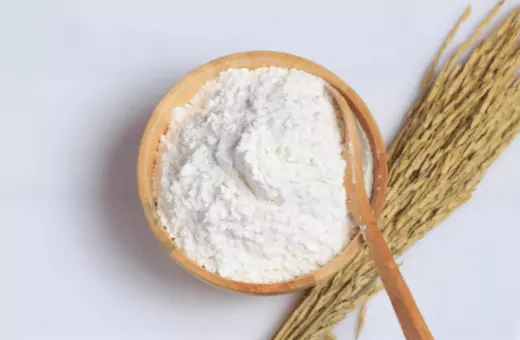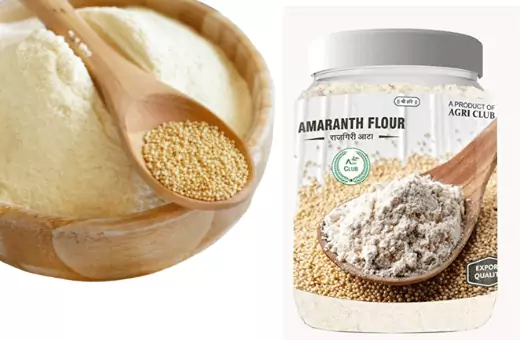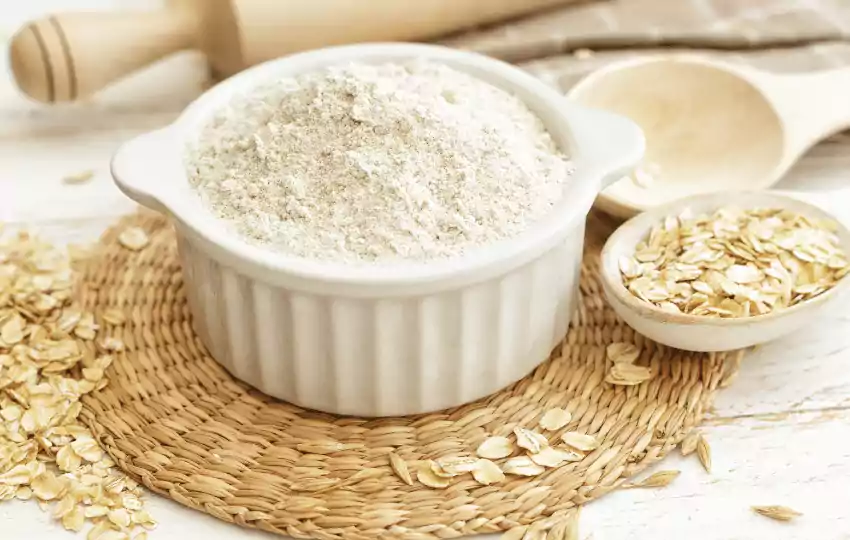Oat flour is the most healthy yet gluten-free flour for a healthy diet. Oat flour has a high fiber content, which is beneficial for digestion. It is also a suitable source of protein and is known to lower cholesterol levels. But when you don’t have oat flour in your kitchen, try using these 6 oat flour substitutes.
These alternatives are healthy, gluten-free choices and easy to find…
6 Ideal Oat Flour substitutes
1. BROWN RICE FLOUR- Best Substitute for Oat Flour
Brown rice flour is easy and similar to oat flour for baking, frying, and thickening sauces.
Brown rice flour is obtained from milling whole grain brown rice. It is a suitable source of dietary fiber, thiamin, niacin, and vitamin B6.

Brown rice flour has a nutty flavor and can be used to make pancakes, waffles, cookies, and bread. It can also be utilized as a thickener for soups and sauces.
Like oat flour, brown rice flour can also be used to make gluten-free baked goods.
2. COCONUT FLOUR- Healthy Oat Flour Substitute
Coconut flour is an amazing choice to replace oat flour for those who are gluten-free or have Celiac disease. It is rich in protein and fiber while also being low in carbohydrates.
It is a wonderful choice for those who are looking to lose weight or maintain a healthy weight, as it helps to stabilize blood sugar levels. Coconut flour can be used in a variety of recipes, including bread, muffins, pancakes, and cookies.
Additionally, coconut flour is jam-packed with nutrients like magnesium, potassium, and zinc.
3. BUCKWHEAT FLOUR- gluten-free oat flour substitute
Another gluten-free alternative for oat flour is buckwheat flour. Buckwheat flour is obtained from the dried and ground kernels of the buckwheat plant.
Buckwheat flour is a good source of fiber, magnesium, and manganese. Buckwheat flour can be utilized in place of wheat flour in most recipes. Buckwheat is popular for making pancakes, noodles, spicy fritters, etc.
Buckwheat has a strong flavor, so it is best to start by using a small amount and gradually add more to taste.
4. Substituting QUINOA FLOUR For Oat Flour is a Great Idea.
Quinoa flour is an excellent choice to replace oat flour in most recipes. Quinoa flour is high in protein and fiber and has a slightly nutty flavor. It’s open at most health food stores.
When baking, be sure to follow the recipe’s measurements carefully, as quinoa flour can vary in weight and absorbency from other flours. one cup of all-purpose flour, for example, is not the same as one cup of quinoa flour. Start by replacing up to 25% of the oat flour in a recipe with quinoa flour, and adjust as needed.
Quinoa flour can be used in various ways, including as a gluten-free flour alternative in baking. It can also be utilized to make pancakes, waffles, bread, pasta, and other dishes.
5. Do You Have ALMOND FLOUR! Great Swap with Oat Flour
Almond flour is another best alternative to oat flour; it has nutty and gluten-free properties. It can be used in cookies, bars, and other baked goods.
If you are looking for flour that will add some protein to your recipes, then almond flour is a perfect choice.
To substitute almond flour for oat flour, use a 1:1 ratio. For every one cup of oat flour called for in a recipe, use one cup of almond flour. Almond flour is a bit denser than oat flour, so you may need to increase the liquid called for in the recipe by 2-3 tablespoons. Bake as usual.
Almond flour is a versatile ingredient that can be used in various recipes.
Here’re some ideas for how to use almond flour:
-Use it as a replacement for all-purpose flour in baking recipes.
-Add it to smoothies or oatmeal to boost protein and healthy fats.
-Use it to make paleo-friendly versions of favorite recipes, like pancakes, waffles, or bread.
-Use it as a coating for chicken or fish before baking or frying.
-Add it to homemade energy bars or granola for an extra boost of nutrition.
You can also utilize almond meal which is made from ground almonds with the skin on. Almond meal is coarser than almond flour and has a slightly nutty taste.
6. AMARANTH FLOUR- Decent Replacement for Oat Flour
Amaranth flour is a great substitute for oat flour in most recipes. It has a similar texture and flavor, and it’s gluten-free. You can find amaranth flour in most health food stores.
To substitute amaranth flour for oat flour, you will need to use about 1/4 cup less amaranth flour than the recipe calls for.
Amaranth flour is denser than oat flour, so it will make your baked goods denser as well. You may also need to add a bit more liquid to your recipe to get the right consistency.

Amaranth flour has a high protein content and is a good source of fiber. It’s also a good source of minerals, including calcium, magnesium, and phosphorous.
Amaranth flour is suitable for making gluten-free bread, muffins, and pancakes. You can also utilize it in place of wheat flour in most recipes.
Amaranth flour is a healthy and versatile addition to your kitchen.
How to Produce Oat flour At Home (Homemade oat flour alternative)
Making your own oat flour is easy and affordable! All you need is some old-fashioned or quick oats and a food processor. Here’s how to do it:
1. Pour the oats into the food processor and pulse until they are ground into a fine flour.
2. Sift the flour to remove any big pieces.
3. Store the flour in an airtight container in the fridge or freezer.
That’s it! You now have fresh oat flour to use in your baking recipes. Enjoy!
Read More- Wheat bran flour substitute
FAQs Related to Oat Flour & Its Alternatives
Q1. What Is Oat Flour Good For?
Oat flour is a good source of dietary fiber, phosphorus, magnesium, and zinc. It has a low glycemic index, which makes it a good choice for people with diabetes or prediabetes.
Oat flour is also gluten-free, which makes it a good option for people who are gluten intolerant or have celiac disease.
Oat flour can be utilized to produce bread, muffins, pancakes, and other baked goods. It can also be used to thicken soups or sauces.
Q2. Is oat flour just ground oats?
Oat flour is ground oats, but not all ground oats are oat flour. Oat flour is produced by crushing whole oats into a fine powder, while rolled or quick oats are just oats that have been chopped into smaller pieces.
Oat flour is often used in baking because it has high fiber content and a mild flavor. It can be replaced with all-purpose flour in most recipes.
Q3. Is oat flour the healthiest?
The healthiest flour for you may vary depending on your specific dietary needs.
However, oat flour is a good option if you are looking for a nutritious and healthy flour alternative. Oats are high in fiber and contain essential vitamins and minerals like potassium, magnesium, and zinc.
Also, they have a lower glycemic index. So, they will not cause blood sugar spikes like some other flours. If you are looking for flour that is both nutritious and tasty, oat flour may be the right choice for you.
Q4. How to make a 1 cup oat flour substitute?
1/2 cup of oat flour + 1/2 cup of all-purpose flour. Mix together and use in the recipe as needed.
Q5. Where to buy oat flour?
You can see oat flour in most grocery stores, or you can make your own by crushing whole oats in a food processor or blender.
If you’re making your own oat flour, be sure to grind the oats until they are a fine powder; otherwise, your baked goods may not turn out well.
Q6. Can I use regular flour instead of oat flour?
If you don’t have oat flour on hand, you can use regular all-purpose flour in its place.
However, keep in mind that oat flour will give your pancakes a slightly different flavor and texture than all-purpose flour.
If you’re searching for something more subtle, go with the all-purpose flour. But if you’re looking for a heartier, nuttier flavor, almond flour is the way to go.
Q7. How much oat flour equals all-purpose flour?
Some recipes call for all-purpose flour, while others call for oat flour. If you’re looking to make a recipe that calls for all-purpose flour with oat flour, how much oat flour do you need?
Generally speaking, 1 cup of all-purpose flour is equivalent to 1/2 cup of oat flour. However, it’s always best to check the recipe you’re using to make sure that the substitution will work.
Oat flour is denser than all-purpose flour, so you may need less oat flour if you’re substituting it for all-purpose flour in a recipe.
Q8. How do you substitute oat flour for baking?
You can replace oat flour with all-purpose flour in a 1:1 ratio in most recipes. However, you may need to add a little extra liquid to your recipe. Oat flour can also be used to make a gluten-free version of many recipes.
Also, you can make oat flour by grinding whole oats in a food processor or blender. If you are using store-bought oat flour, make sure to read the ingredients list to ensure that the flour is gluten-free.
Some oat flours may contain wheat flour, which would make the flour not gluten-free.
Oat flour is a good source of dietary fiber, phosphorus, magnesium, and zinc. It has a low glycemic index, which makes it a good choice for people with diabetes or prediabetes.
Oat flour is also gluten-free, which makes it a good option for people who are gluten intolerant or have celiac disease.
Oat flour can be utilized to produce bread, muffins, pancakes, and other baked goods. It can also be used to thicken soups or sauces.

